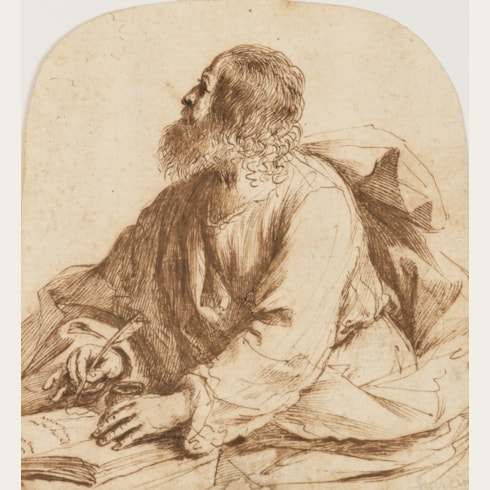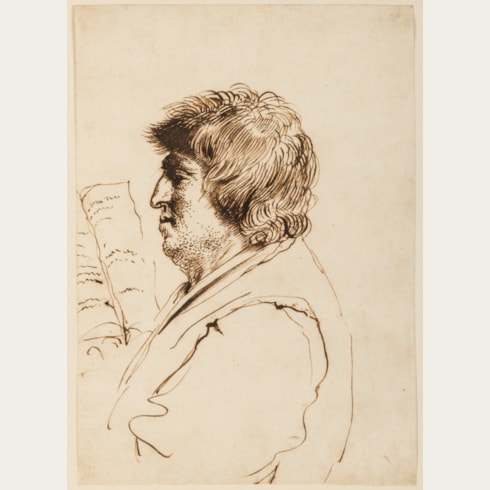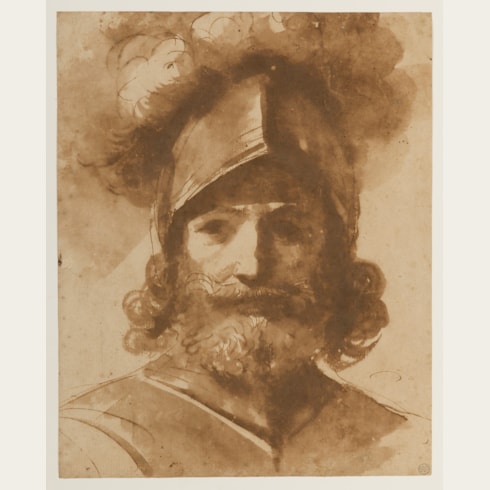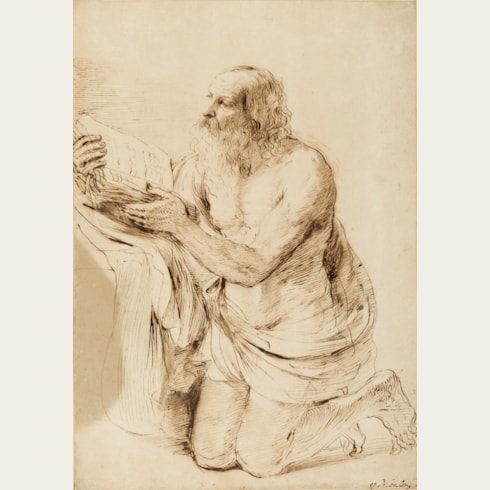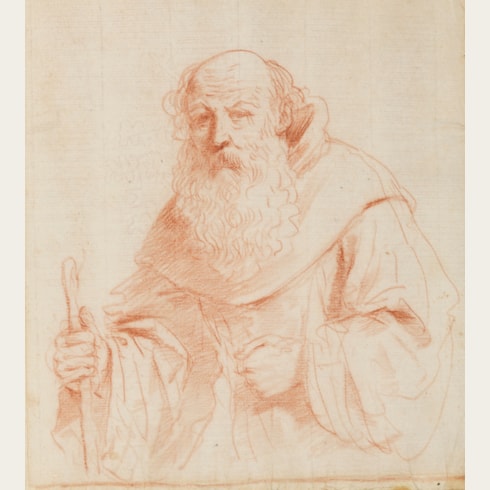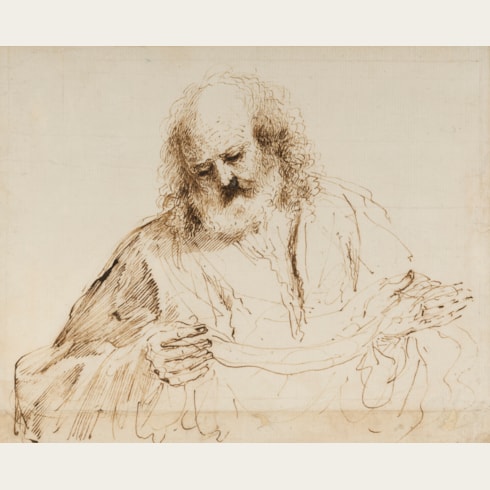Giovanni Francesco Barbieri GUERCINO
(Cento 1591 - Bologna 1666)
The Madonna of Loreto in a Niche
Another depiction of the same subject in pen and brown ink on the verso.
212 x 165 mm. (8 3/8 x 6 1/2 in.)
Both sides of the present sheet are preparatory studies for an engraving, in reverse, depicting the Madonna of Loreto in a niche with putti above, by the Centese printmaker Giovanni Battista Pasqualini (1595-1631). From around 1618 until his death in 1631 Pasqualini was closely associated with Guercino, producing numerous engravings after his compositions which led to the young painter’s work becoming known well beyond their native Cento. Pasqualini even accompanied Guercino when he travelled to Rome in 1621, and by the end of his brief career had engraved nearly sixty prints after both paintings and drawings by him. At best, however, Pasqualini remained a printmaker of only modest talent, and Guercino must have struggled to ensure that his compositions were reproduced as accurately as possible. As Nicholas Turner has pointed out, ‘With ‘provincial’ engravers, such as [Gianfrancesco] Mucci and Pasqualini, the supervision required would have been considerable, even though the artist must have realized from the outset that the quality of their engravings was never going to be high, despite his attempts to control their work.’ An indication of how closely the artist supervised Pasqualini’s process is seen in a handful of proof impressions of engravings by the latter which display corrections in pen and ink by Guercino that were later incorporated into the final state of the prints.
Although the related engraving is dated 1628, the present sheet may be a few years earlier in date. As the Guercino scholar David Stone has noted, ‘Pasqualini’s print must derive from a drawing (now lost) by Guercino, one that is not necessarily as late as 1628. Pasqualini often used Guercino drawings and paintings of earlier years as sources for his engravings.’ The print bears an extensive dedication to the archpriest and canons of the church of San Biagio in Cento from a certain Bartolomeo Lori, a native of Loreto living in Cento, who presumably commissioned the engraving from Pasqualini. As an act of faith and penitence, Lori is said to have carried the statue of the Madonna of Loreto on his shoulders from Loreto to Cento as a gift to the Augustinian nuns of the church of Santa Maria Maddalena there. A copy of the Madonna of Loreto is, in fact, still in situ in the church today. It is interesting to note, however, that on the recto of the present sheet Guercino has drawn the Christ Child looking outwards, as He appears in the statue itself, but on the verso the artist drew the Child looking slightly to the right, which would suggest that the artist was not interestd in producing a straightforward copy of the famous sculpture.
Guercino had depicted the Madonna of Loreto in an early, signed canvas of Saints Bernardino of Siena and Francis of Assisi Praying before the Madonna of Loreto, painted in 1618 for the church of San Pietro in Cento and now in the Pinacoteca Civica there, but in that altarpiece the statue is seen from the side and deep in shadow. Much closer to the present sheet is the frontal depiction of the Madonna of Loreto in two related pen and wash drawings of Souls in Purgatory Supplicating the Madonna of Loreto by Guercino, one in the National Gallery of Canada in Ottawa and the other in the Albertina in Vienna. Both drawings are, however, unconnected to any surviving painting by the artist.
A stylistically and thematically related drawing of The Nativity in a Fictive Frame Supported by Two Angels by Guercino appeared at auction in 2005 and is now in the Grimaldi Fava collection in Cento. The Cento drawing is likewise based on an earlier sculpture; a 15th century stucco relief of The Nativity by a follower of Donatello which had been venerated in Cento since the early 16th century, and which remains in the church of Santi Sebastiano e Rocco there. As the scholar Fausto Gozzi has written of the Cento drawing, in terms that are apposite to the present sheet, ‘This drawing…is an extraordinary example of Guercino’s draughtsmanship. Here the master displays all his power to depict a subject succinctly, with economy of expression. The pen seems to dance over the paper with a constant movement, leaping and then pausing momentarily, but almost never breaking off the restless line...’ Like the present sheet, the Cento drawing was later engraved, by the local printmaker Matteo Mingarini, in a print dated 1634.
Among stylistically comparable drawings of the second half of the 1620s by Guercino is a Madonna of the Rosary of c.1627-1628 in the Uffizi in Florence, which is a design for a wooden statue, by an unknown sculptor, intended for a church in Cento.
Giovanni Francesco Barbieri, known as Il Guercino (‘the squinter’) because he was cross-eyed, was by the second decade of the 17th century one of the leading painters in the province of Emilia. Born in Cento, a small town between Bologna and Ferrara, Guercino was largely self-taught, although his early work was strongly influenced by the paintings of Ludovico Carracci. In 1617 he was summoned to Bologna by Alessandro Ludovisi, the Cardinal Archbishop of Bologna, and there painted a number of important altarpieces, typified by the Saint William Receiving the Monastic Habit, painted in 1620 and now in the Pinacoteca Nazionale in Bologna. When Ludovisi was elected Pope Gregory XV in 1621, Guercino was summoned to Rome to work for the pontiff and his nephew, Cardinal Ludovico Ludovisi. It was in Rome that Guercino painted some of his most celebrated works, notably the ceiling fresco of Aurora in the Casino Ludovisi and the large altarpiece of The Burial and Reception into Heaven of Saint Petronilla for an altar in Saint Peter’s. The papacy of Gregory XV was short-lived, however, and on the death of the Pope in 1623 Guercino returned to his native Cento. He remained working in Cento for twenty years, though he continued to receive commissions from patrons throughout Italy and beyond, and turned down offers of employment at the royal courts in London and Paris. Following the death of Guido Reni in 1642, Guercino moved his studio to Bologna, where he received commissions for religious pictures of the sort that Reni had specialized in, and soon inherited his position as the leading painter in the city.
Guercino was among the most prolific draughtsmen of the 17th century in Italy, and his preferred medium was pen and brown ink, although he also worked in red chalk, black chalk, and charcoal. He appears to have assiduously kept his drawings throughout his long career, and to have only parted with a few of them. Indeed, more drawings by him survive today than by any other Italian artist of the period. On his death in 1666 all of the numerous surviving sheets in his studio passed to his nephews and heirs, the painters Benedetto and Cesare Gennari, known as the ‘Casa Gennari’.
The drawings of Guercino, which include figural and compositional studies, landscapes, caricatures and genre scenes, have always been coveted by later collectors and connoisseurs. Indeed, the 18th century amateur Pierre-Jean Mariette noted of the artist that ‘Ce peintre a outre cela une plume tout-à-faite séduisante’. The largest extant group of drawings by Guercino is today in the Royal Collection at Windsor Castle; these were acquired from the Gennari family by King George III’s librarian, Richard Dalton, between about 1758 and 1764.
Provenance
Private collection, London.
Literature























